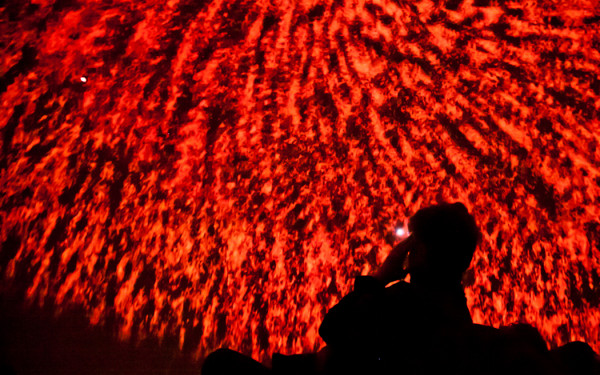Let It Enfold You
Immersive Experimental Film ‘Six Mil Antennas – The Final Cut’ Screens for Second Run in the SATosphere
If you’ve never before beheld the glory of a full-dome theatre, you’ve come to the right city—Montreal’s multi-platform venue La Societé des Arts Technologiques is continuing to break ground in the international arena by screening experimental works in its massive exhibition dome, the SATosphere.
Putting IMAX screens to shame, the SATosphere is unique not just for the content it screens, but the way it screens it—in immersive 360-degree dome theatres elsewhere rarely used in the domain of art.
“There are a few domes in Germany, [but] most of the time it’s planetariums presenting more scientific-based films,” said visual artist and experimental filmmaker Johnny Ranger, who is screening his film Six Mil Antennas – The Final Cut this month in the SATosphere.
“You can see over there that there’s a real interest in what the SAT is doing, because the SAT is probably the only [venue in the world] that has a dome dedicated to experimental art.”
Six Mil Antennas – The Final Cut is the SATosphere’s latest offering, screening the film for a second time after first presenting it last fall. The film is an updated version of its original 2011 showing, then titled simply Six Mil Antennas.
“It wouldn’t work as much to see it on a small screen,” Ranger said, describing the immersive nature of the film.
Ranger started his career as a visual artist for DJs’ live shows in Montreal before branching into creating interdisciplinary works, blending multiple mediums. He came up with the idea for the experimental full-dome piece in 2009.
Filmed in 2011, Ranger says the movie was especially tricky to produce, as the SATosphere wasn’t even fully constructed until October of that year.
“The dome was not constructed when we were making the film, so we couldn’t test it in the space, we just had to imagine,” he said with a laugh. “It was quite something to imagine.”
The result of that imagination is nothing short of a trippy, bewildering endeavour that traverses dreams, drugs, visions and multiple realities.
Ranger says the movie was inspired by the work of John C. Lilly, an unconventional scientist best known for his studies with dolphin intelligence and his invention of the sensory deprivation chamber in the ‘50s, a dark soundproof tank filled with warm water that aims to plumb the depths of human consciousness with no sensory stimulation.
“He was experimenting with drugs inside these isolation tanks to go into the depths of his psyche,” Ranger said, mentioning ketamine as one of those drugs.
“From that, there’s an interest [I developed] in some kind of different, multi-level reality that’s sometimes associated with shamanic experiences.”
Ranger also credits Rick Strassman’s research on the mysterious hallucinogenic drug dimethyltryptamine—or DMT for short—as inspiration for his film, citing Strassman’s book DMT: The Spirit Molecule, published in 2000.
“There’s definitely something to be connected there, between psychology and psychedelics,” he said.
Spirituality is also a motif of the film, drawing from Buddhist beliefs about the nature of the universe, and one of the religion’s symbols in particular.
“Parts of the movie were inspired by Tibetan mandalas—this idea of wheels of time, and wheels of life intertwined, and how everything is a big intertwined moving puzzle,” said Ranger.
Aside from providing mind-bending visuals that thrust your consciousness in parallel realities and consume your psyche, the film has political elements as well. One of the main recurring images is a never-ending line of oil pumpjacks and refineries belching the smoke and waste of burned fossil fuels into the atmosphere.
“It’s a social critique,” said Ranger. “There are a lot of associations for people to interpret. There are definitely many layers of ecology, petrol, virtual realities, what is real and what is not real, all of this.”
As for the full-dome theatre format itself, Ranger expects its popularity to grow as more experimental filmmakers begin to use it.
“There’s a lot of experimentation that can be done, not just on the screen but in the space, using set design and incorporating dance and performance,” he said. “There are so many ways you can create a narrative inside the dome, and you can use it as an immersive, virtual environment.”
Ranger also says the encapsulating format is a great way to open moviegoers’ minds to the endless ways they can see and interact with films.
“People, when they come into that space, are open for anything,” he said.
“First of all, they’re not sitting in a seat necessarily, they’re sometimes lying down, so your mind is totally open in a different way. You don’t expect that you’re going to see a normal movie,” he continued.
“It seems to swirl you into a world that is a bit surprising.”
Six Mil Antennas – The Final Cut [18+] // Oct. 29 to Nov. 22 // La Societé des Arts Technologiques (1201 St. Laurent Blvd.) // Tuesdays to Fridays, 7 p.m. // $15 film, $49 film + Foodlab dinner

_900_597_90.jpg)
_900_597_90.jpg)
_900_597_90.jpg)
_697_1050_90.jpg)
_697_1050_90.jpg)
_600_832_s.png)

_600_375_90_s_c1.jpg)


_600_375_90_s_c1.jpg)